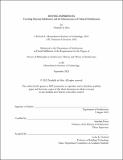Moving Experiences: Traveling Museum Exhibitions and the Infrastructures of Cultural Globalization
Author(s)
de Silva, Nushelle
DownloadThesis PDF (1.676Mb)
Advisor
Dutta, Arindam
Terms of use
Metadata
Show full item recordAbstract
In the wake of two world wars, traveling museum exhibitions were touted as a model for advancing peace, broadening the views of diverse publics by compelling museums across borders to share their treasures. In this dissertation, I examine how the establishment of a global infrastructure for museum exchange was established by two organizations dedicated to cultural peacebuilding: the United Nations Educational, Scientific, and Cultural Organization (UNESCO), and the International Council of Museums (ICOM). I argue that while these ambitions spatially reorganized museums in the latter half of the twentieth century to prioritize object exchange over accumulation, the uneven globalization facilitated by exhibitions still augments rather than alleviates the coloniality of museums.
UNESCO and ICOM led the charge to instate international administrative standards for circulating museum exhibitions in increased quantities, encompassing packing solutions, border inspections, climate requirements, and risk management. I examine their efforts to establish uniform practices across museums through increasingly standardized paperwork: manuals for professional practice, exhibition loan and insurance agreements, object condition and facility reports, and customs labels. These documents were critical interfaces for negotiating the definition of art and determining parameters for a homogenized global museum interior optimized for exchange. These standards shored up the power of dominant institutions, sanctioning their situated practices and the conservation needs of their specific object collections as universally applicable.
Instead of augmenting scholarship on how museums developed their collections, I attend to how museums developed relationships of exchange. Rather than trace the itineraries of the individual objects that traveled, then, I examine the forms of paperwork that authorized their mobility and the spatial normalizations these documents instigated: the reconfiguration of registration and storage facilities to enable object movement; the relocation of border inspections to museum premises; the establishment of climate and building security standards. Albeit availing itself of the infrastructures of globalized trade, this emerging governmental apparatus of exhibition circulation was discursively constructed as an instrument of conservation. Traveling exhibitions persuasively guide our appraisals of art. As this dissertation demonstrates, administrative practices play a determinative role in object mobility and must be untangled to address inequitable cultural representation in the museum.
Date issued
2022-09Department
Massachusetts Institute of Technology. Department of ArchitecturePublisher
Massachusetts Institute of Technology